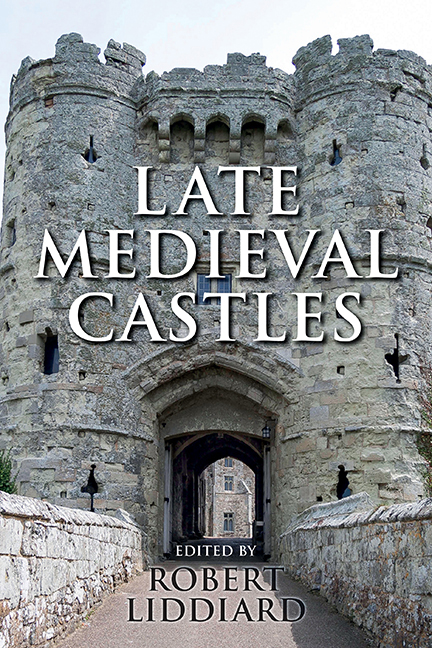Book contents
- Frontmatter
- Contents
- List of Illustrations
- Acknowledgements
- Editor's Preface
- List of Abbreviations
- A Note on the Text
- Introduction
- 1 Fourteenth-Century Castles in Context: Apotheosis or Decline?
- 2 Architects, Advisors and Design at Edward I's Castles in Wales
- 3 The Courtyard and the Tower: Contexts and Symbols in the Development of Late Medieval Great Houses
- 4 Castle Planning in the Fourteenth Century
- 5 Meaningful Constructions: Spatial and Functional Analysis of Medieval Buildings
- 6 Mota, Aula et Turris: The Manor-Houses of the Anglo-Scottish Border
- 7 Lulworth Castle, Dorset
- 8 A Scottish Problem with Castles
- 9 Structural Symbolism in Medieval Castle Architecture
- 10 Specimens of Freedom to Crenellate by Licence
- 11 Some Analysis of the Castle of Bodiam, East Sussex
- 12 English Castles in the Reign Of Edward II
- 13 Castles of Ward and the Changing Pattern of Border Conflict in Ireland
- 14 The Donjon Of Knaresborough: The Castle As Theatre
- 15 The Architecture of Arthurian Enthusiasm: Castle Symbolism in the Reigns of Edward I and his Successors
- 16 Medieval Ornamental Landscapes
- 17 Otherworld Castles in Middle English Arthurian Romance
- Guide to Further Reading
- Index
10 - Specimens of Freedom to Crenellate by Licence
Published online by Cambridge University Press: 29 April 2017
- Frontmatter
- Contents
- List of Illustrations
- Acknowledgements
- Editor's Preface
- List of Abbreviations
- A Note on the Text
- Introduction
- 1 Fourteenth-Century Castles in Context: Apotheosis or Decline?
- 2 Architects, Advisors and Design at Edward I's Castles in Wales
- 3 The Courtyard and the Tower: Contexts and Symbols in the Development of Late Medieval Great Houses
- 4 Castle Planning in the Fourteenth Century
- 5 Meaningful Constructions: Spatial and Functional Analysis of Medieval Buildings
- 6 Mota, Aula et Turris: The Manor-Houses of the Anglo-Scottish Border
- 7 Lulworth Castle, Dorset
- 8 A Scottish Problem with Castles
- 9 Structural Symbolism in Medieval Castle Architecture
- 10 Specimens of Freedom to Crenellate by Licence
- 11 Some Analysis of the Castle of Bodiam, East Sussex
- 12 English Castles in the Reign Of Edward II
- 13 Castles of Ward and the Changing Pattern of Border Conflict in Ireland
- 14 The Donjon Of Knaresborough: The Castle As Theatre
- 15 The Architecture of Arthurian Enthusiasm: Castle Symbolism in the Reigns of Edward I and his Successors
- 16 Medieval Ornamental Landscapes
- 17 Otherworld Castles in Middle English Arthurian Romance
- Guide to Further Reading
- Index
Summary
Self-advertising noblemen, ecclesiastics, gentry and merchants, between 1200 and 1578, obtained licence to fortify 409 castles and manors, 43 religious establishments, and about 55 towns and town houses. Taking fifteen case-studies, put in context, Dr Charles Coulson illustrates the results of aristocratic aspiration on the ground and in the records.
The truth about licences to crenellate is as remote from tradition as it is with Bodiam Castle (Fortress 10 (1991), 3–15). Since the error is widespread we need only refer to the late David Cathcart King's great Castellarium Anglicanum to give the essence of it. He wrote of early baronial fortresses: ‘the king's concern with these private castles was inevitable. Over their foundation he had the negative control of requiring licences to crenellate.’ This he modified for the reigns of the first three Norman kings, believing that ‘in general, barons built castles where they pleased on their fiefs’, caution more than confirmed by Richard Eales (1990) and the present writer. Traditional ideas derive from the notion that feudalism was essentially anarchic, and ‘private castles’ as hostile to the peace and to royal power as the ‘turbulent barons’ who built them; combined with faith in the virility of monarchy in England, unlike Europe. So David King then qualified his previous realism: ‘the requirement of a licence to crenellate enabled the kings to control the building of new castles so well that, from the reign of Stephen onwards, it is impossible to think of more than one permanent castle built for a purpose hostile to the Crown’. He had in mind ‘the remote and sinister Dunstanburgh’.
But relatively few castles were founded after the great post-Conquest explosion. Regulation of additional fortification (e.g. Thomas of Lancaster's Pontefract) not of new castles was needed if kings really had wished to check them, strong ones particularly. In fact, the famous ‘adulterine castles’ of the 1135–54 Anarchy were simply objectionable to the few contemporary clerics who used the term, not unlicensed. Until the reign of King John there are no true licences; and when they begin to be known their character is honorific not restrictive. They signified royal favour, like other privileges, but most castle-builders did not trouble to ask for it.
- Type
- Chapter
- Information
- Late Medieval Castles , pp. 221 - 240Publisher: Boydell & BrewerPrint publication year: 2016



